Fintechs and Institutions: Evidence from an Emerging Economy
Abstract
1. Introduction
2. Fintechs
2.1. Institutions: An Integrative Approach
2.2. The Evolutionary Process of Institutional Change Brought on by Fintechs
3. Method
3.1. Study Design
3.2. Case Characterization
3.3. Data Collection
3.4. Data Analysis and Summary
4. Findings
4.1. Dematerialization of Access
4.1.1. Digital Literacy
“A long time ago, talking about applications was something that people only understood as savings, fixed income, something that was barely explored. Nowadays, in the financial market, anywhere you go online […] everything talks about the financial market in a very detailed manner that everyone understands”.
4.1.2. Access Democratization
“It is a single channel on the platform to which everyone has the same access. The platform is the same for all. So if I want credit, I go there and I see if there is credit available to me, just like any other person, regardless of social class”.
4.1.3. Financial Inclusion
“The point is to give people without access to credit, access to certain financial products that can benefit then… And what do we do for them? We make their applications more secure and efficient. The larger the public they can reach, the more need they have to hire us, so we have indirect gains”.
4.2. Operational Architecture
4.2.1. Facilitation of P2P Resources
4.2.2. Financial Incentives
“For the actual entrepreneurs, you begin to notice that there is the opportunity for a partnership with a certain market that you wouldn’t have access to by yourself. You end up providing the final users with more opportunities, which to them translates into lower prices, more products, and more offers”.
4.2.3. Elimination of Intermediaries
“Now, also based on new regulations, there are other infrastructures in the financial market that belong to depositary registers which are also going digital. There is increased competition with new companies currently acting in this field”.
4.2.4. Digital Contracts
“Of course, the institutions are concerned about frauds. So, they have to specialize themselves in this operation model […] there are advanced systems that conduct identity and identity theft verification”.
4.3. Transactional Regulation
4.3.1. Integration of Regulatory Technologies
4.3.2. Integration of Regulatory Platforms
“I do not believe that the regulation itself was broken. It will be broken later on due to open banking. Because we changed this model of transaction percentage fees to a model of transaction fees… And the fintechs are the driving force behind this cost reduction”.
4.3.3. Integration of Regulatory Authorities
4.4. Transactional Efficiency
4.4.1. Shared Economy
“There are many things in the banking spread that the financial institution must cover. One of them is the institution’s own costs, its funding costs, deposit costs, and operational costs… Then, if you compare it with the banks, there are the opportunity costs, inflation costs, the operation’s liquidity premium. For the fintechs, this type of operational cost matters the most. So operational costs were significantly reduced. And not just fintechs, but any institution that decides to invest in digitalizing its processes ends up getting returns pertaining to its costs”.
4.4.2. Security of Operations
“My mother raised me, telling me to not talk to strangers. Now, I get into an unknown person’s car just because he has five stars… So I think that technology plays a fundamental role in creating this bridge and this confidence”.
4.4.3. Technological Risk Management
“We try to work with cryptographed client data, which makes it much more difficult for others to access our base. Double authentication is a factor that also helps customers protect themselves in their operations”.
5. Contributions
5.1. An Integrative Framework
5.2. Propositions
6. Final Considerations
Author Contributions
Funding
Institutional Review Board Statement
Informed Consent Statement
Data Availability Statement
Conflicts of Interest
| 1 |
References
- Adamyk, B., Benson, V., Adamyk, O., & Liashenko, O. (2025). Risk management in DeFi: Analyses of the innovative tools and platforms for tracking DeFi transactions. Journal of Risk and Financial Management, 18(1), 38. [Google Scholar] [CrossRef]
- Amar, S., & Pratama, I. (2020). Exploring the link between income inequality, poverty reduction and economic growth: An ASEAN perspective. International Journal of Innovation, Creativity and Change, 11(2), 24–41. [Google Scholar]
- Anagnostopoulos, I. (2018). Fintech and regtech: Impact on regulators and banks. Journal of Economics and Business, 100, 7–25. [Google Scholar] [CrossRef]
- Bellardini, L., Del Gaudio, B. L., Previtali, D., & Verdoliva, V. (2022). How do banks invest in fintechs? Evidence from advanced economies. Journal of International Financial Markets, Institutions and Money, 77, 101498. [Google Scholar] [CrossRef]
- Berger, P., & Luckmann, T. (2016). The social construction of reality. In Social theory re-wired (pp. 110–122). Routledge. [Google Scholar]
- Bollaert, H., Lopez-de-Silanes, F., & Schwienbacher, A. (2021). Fintech and access to finance. Journal of corporate finance, 68, 101941. [Google Scholar] [CrossRef]
- Brophy, R. (2020). Blockchain and insurance: A review for operations and regulation. Journal of financial regulation and compliance, 28(2), 215–234. [Google Scholar] [CrossRef]
- Brownsword, R. (2019). Regulatory fitness: Fintech, funny money, and smart contracts. European Business Organization Law Review, 20(1), 5–27. [Google Scholar] [CrossRef]
- Bukhtiarova, A., Hayriyan, A., Bort, N., & Semenog, A. (2018). Modeling of FinTech market development (on the Example OF Ukraine). Innovative Marketing, 14(4), 34–45. [Google Scholar] [CrossRef][Green Version]
- Campanella, F., Serino, L., & Crisci, A. (2022). Governing Fintech for sustainable development: Evidence from Italian banking system. Qualitative Research in Financial Markets, 15(4), 557–571. [Google Scholar] [CrossRef]
- Carlos, R. L., de Souza, E. B., & Mattos, C. A. (2024). Enhancing circular economy practices through the adoption of digital technologies. Business Strategy & Development, 7(1), e330. [Google Scholar]
- Chang, C. L., McAleer, M., & Wong, W. K. (2020). Risk and financial management of COVID-19 in business, economics and finance. Journal of Risk and Financial Management, 13(5), 102. [Google Scholar] [CrossRef]
- Chen, Y., & Bellavitis, C. (2020). Blockchain disruption and decentralized finance: The rise of decentralized business models. Journal of Business Venturing Insights, 13, e00151. [Google Scholar] [CrossRef]
- Chen, Y., Wang, G. J., Zhu, Y., Xie, C., & Uddin, G. S. (2023). Quantile connectedness and the determinants between FinTech and traditional financial institutions: Evidence from China. Global Finance Journal, 58, 100906. [Google Scholar] [CrossRef]
- Chiu, I. H. (2017). A new era in fintech payment innovations? A perspective from the institutions and regulation of payment systems. Law, Innovation and Technology, 9(2), 190–234. [Google Scholar] [CrossRef]
- Conlon, T., Corbet, S., & McGee, R. J. (2020). Are cryptocurrencies a safe haven for equity markets? An international perspective from the COVID-19 pandemic. Research in International Business and Finance, 54, 101248. [Google Scholar] [CrossRef] [PubMed]
- Cumming, D. J., & Schwienbacher, A. (2018). Fintech venture capital. Corporate Governance: An International Review, 26(5), 374–389. [Google Scholar] [CrossRef]
- da Rosa München, D. (2022). The effect of financial distress on capital structure: The case of Brazilian banks. The Quarterly Review of Economics and Finance, 86, 296–304. [Google Scholar] [CrossRef]
- Deng, H., Huang, R. H., & Wu, Q. (2018). The regulation of initial coin offerings in China: Problems, prognoses and prospects. European Business Organization Law Review, 19(3), 465–502. [Google Scholar] [CrossRef]
- DiMaggio, P. (1988). Interest and agency in institutional theory. Institutional Patterns and Organizations Culture and Environment, 3–21. Available online: https://cir.nii.ac.jp/crid/1571417125735103744 (accessed on 1 February 2025).
- DiMaggio, P. J., & Powell, W. W. (1983). The iron cage revisited: Institutional isomorphism and collective rationality in organizational fields. American Sociological Review, 48, 147–160. [Google Scholar] [CrossRef]
- Doré, N. I., & Teixeira, A. A. (2023). The role of human capital, structural change, and institutional quality on Brazil’s economic growth over the last two hundred years (1822–2019). Structural Change and Economic Dynamics, 66, 1–12. [Google Scholar] [CrossRef]
- Feld, M., de Barcellos Giacobbo, T. S. F., & Schuster, W. E. (2021). Technological progress and finance: The effects of digitization on Brazilian banking fees. EconomiA, 22(2), 85–99. [Google Scholar] [CrossRef]
- Finnovation. (2019, May). Mapa de fintechs—Brasil (May 2019) [Map of fintechs—Brazil]. Available online: https://finnovation.com.br/wpcontent/uploads/2019/09/FINNOVATION-Mapa-Fintechs-Brasil-SET2019.pdf (accessed on 10 July 2022).
- Fletcher, M., & Plakoyiannaki, E. (2011). Case selection in international business: Key issues and common misconceptions. In Rethinking the case study in international business and management research. Edward Elgar Publishing. [Google Scholar]
- Giddens, A. (1984). The constitution of society: Outline of the theory of structuration. Univ of California Press. [Google Scholar]
- Gomber, P., Koch, J. A., & Siering, M. (2017). Digital Finance and FinTech: Current research and future research directions. Journal of Business Economics, 87(5), 537–580. [Google Scholar] [CrossRef]
- Hadad, S., & Bratianu, C. (2019). Dematerialization of banking products and services in the digital era. Management & Marketing, 14(3), 318–337. [Google Scholar]
- Hassan, M. K., Rabbani, M. R., & Ali, M. A. M. (2020). Challenges for the Islamic Finance and banking in post COVID era and the role of Fintech. Journal of Economic Cooperation & Development, 41(3), 93–116. [Google Scholar]
- Hassan, M. K., Rabbani, M. R., & Rashid, M. (Eds.). (2023). FinTech in islamic financial institutions: Scope, challenges, and implications in islamic finance. Springer Nature. [Google Scholar]
- Hassan, M. K., Zulfikar, Z., Rabbani, M. R., & Atif, M. (2022). Fintech trends: Industry 4.0, Islamic fintech, and its digital transformation. In FinTech in islamic financial institutions: Scope, challenges, and implications in islamic finance (pp. 113–130). Springer International Publishing. [Google Scholar]
- Hawksworth, J., Clarry, R., & Audino, H. (2017). How will the global economic order change by 2050. Price water house coopers (PWC), UK. Available online: https://www.pwc.com/gx/en/world-2050/assets/pwc-the-world-in-2050-full-report-feb-2017.pdf (accessed on 3 May 2023).
- Hodson, D. (2021). The politics of FinTech: Technology, regulation, and disruption in UK and German retail banking. Public Administration, 99(4), 859–872. [Google Scholar] [CrossRef]
- Huang, R. H., Cheung, C. S. W., & Wang, C. M. L. (2020). The risks of mobile payment and regulatory responses: A Hong Kong perspective. Asian Journal of Law and Society, 7(2), 325–343. [Google Scholar] [CrossRef]
- IBGE. (2023). Produto interno bruto–PIB (gross domestic product-GDP). Instituto Brasileiro de Geografia e Estatística. Available online: https://www.ibge.gov.br/explica/pib (accessed on 3 May 2023).
- Irwin, A. S., & Dawson, C. (2019). Following the cyber money trail: Global challenges when investigating ransomware attacks and how regulation can help. Journal of Money Laundering Control, 22(1), 110–131. [Google Scholar] [CrossRef]
- Jain, S., & Gabor, D. (2020). The rise of digital financialization: The case of India. New Political Economy, 25(5), 813–828. [Google Scholar] [CrossRef]
- Ji, Q., Zhang, D., & Zhao, Y. (2020). Searching for safe-haven assets during the COVID-19 pandemic. International Review of Financial Analysis, 71, 101526. [Google Scholar] [CrossRef]
- Jiang, Y., Ho, Y. C., Yan, X., & Tan, Y. (2018). Investor platform choice: Herding, platform attributes, and regulations. Journal of Management Information Systems, 35(1), 86–116. [Google Scholar] [CrossRef]
- Joia, L. A., & Cordeiro, J. P. V. (2021). Unlocking the potential of fintechs for financial inclusion: A Delphi-based approach. Sustainability, 13(21), 11675. [Google Scholar] [CrossRef]
- Jünger, M., & Mietzner, M. (2019). Banking goes digital: The adoption of FinTech services by German households. Finance Research Letters, 34, 101260. [Google Scholar] [CrossRef]
- Kim, J. C., Mazumder, S., & Saha, P. (2025). Environmental risk concern and short-term IPO performance of green stocks during the COVID-19 crisis period. Journal of Risk and Financial Management, 18(3), 157. [Google Scholar] [CrossRef]
- Kraus, K., Kraus, N., & Osetskyi, V. (2020). New quality of financial institutions and business management. Baltic Journal of Economic Studies, 6(1), 59–66. [Google Scholar] [CrossRef]
- Lee, C. C., Ni, W., & Zhang, X. (2023). FinTech development and commercial bank efficiency in China. Global Finance Journal, 57, 100850. [Google Scholar] [CrossRef]
- Lee, I., & Shin, Y. J. (2018). Fintech: Ecosystem, business models, investment decisions, and challenges. Business Horizons, 61(1), 35–46. [Google Scholar] [CrossRef]
- Maciel, L. S. (2023). Brazilian stock-market efficiency before and after COVID-19: The roles of fractality and predictability. Global Finance Journal, 58, 100887. [Google Scholar] [CrossRef]
- Meyer, J. W., & Rowan, B. (1977). Institutionalized organizations: Formal structure as myth and ceremony. American Journal of Sociology, 83(2), 340–363. [Google Scholar] [CrossRef]
- Mills, A., Eurepos, G., & Wiebe, E. (2010). Encyclopedia of case study research. I. SAGE Publications. [Google Scholar]
- Muganyi, T., Yan, L., Yin, Y., Sun, H., Gong, X., & Taghizadeh-Hesary, F. (2022). Fintech, regtech, and financial development: Evidence from China. Financial innovation, 8(1), 1–20. [Google Scholar] [CrossRef]
- North, D. C. (1990). Institutions, institutional change and economic performance. Cambridge University Press. [Google Scholar]
- North, D. C. (1991). Institutions. Journal of Economic Perspectives, 5(1), 97–112. [Google Scholar] [CrossRef]
- North, D. C. (2005). Institutions and the process of economic change. Management International, 9(3), 1–7. [Google Scholar] [CrossRef]
- Ozili, P. K. (2018). Impact of digital finance on financial inclusion and stability. Borsa Istanbul Review, 18(4), 329–340. [Google Scholar] [CrossRef]
- Pazarbasioglu, C., Mora, A. G., Uttamchandani, M., Natarajan, H., Feyen, E., & Saal, M. (2020). Digital financial services (p. 54). World Bank. [Google Scholar]
- Petrushenko, Y., Kozarezenko, L., Glinska-Newes, A., Tokarenko, M., & But, M. (2018). The opportunities of engaging FinTech companies into the system of cross-border money transfers in Ukraine. Investment Management & Financial Innovations, 15(4), 332. [Google Scholar]
- Puschmann, T. (2017). FinTech. Business & Information Systems Engineering, 59(1), 69–76. [Google Scholar]
- Qian, L., Jiang, Y., Long, H., & Song, R. (2020). The roles of economic policy uncertainty and the COVID-19 pandemic in the correlation between cryptocurrency and stock markets. The Singapore Economic Review, 1–30. [Google Scholar] [CrossRef]
- Qureshi, F., Rea, S. C., & Johnson, K. N. (2021). (Dis) creating claims of financial inclusion: The integration of artificial intelligence in consumer credit markets in the United States and Kenya. Journal of International and Comparative Law, 8(2), 405–433. [Google Scholar]
- Rabbani, M. R., Hassan, M. K., Miah, M. D., & Grewal, H. (2022a). Fintech and the art of disruption. In FinTech in islamic financial institutions: Scope, challenges, and implications in islamic finance (pp. 29–47). Springer International Publishing. [Google Scholar]
- Rabbani, M. R., Hassan, M. K., & Rashid, M. (2022b). Introduction to Islamic fintech: A challenge or an opportunity? In FinTech in islamic financial institutions: Scope, challenges, and implications in islamic finance (pp. 1–27). Springer International Publishing. [Google Scholar]
- Rahman, S. M., Saif, A. N. M., Kabir, S., Bari, M. F., Alom, M. M., Rayhan, M. J., Zan, F., Chu, M., & Talukder, A. (2025). Blockchain in the banking industry: Unravelling thematic drivers and proposing a technological framework through systematic review with bibliographic network mapping. IET Blockchain, 5(1), e12093. [Google Scholar] [CrossRef]
- Rao, S., Pan, Y., He, J., & Shangguan, X. (2022). Digital finance and corporate green innovation: Quantity or quality? Environmental Science and Pollution Research, 29(37), 56772–56791. [Google Scholar] [CrossRef]
- Rehman, Z., Akhtar, R., & Shah, S. A. (2022). The impact of fintech on banks with historical, contemporary and future perspective with legal perception. Journal of Development and Social Sciences, 3(3), 108–116. [Google Scholar]
- Romanova, I., Grima, S., Spiteri, J., & Kudinska, M. (2018). The payment services Directive II and competitiveness: The perspective of European fintech companies. European Research Studies, 21(2), 3–22. [Google Scholar] [CrossRef]
- Ruhland, P., & Wiese, F. (2022). FinTechs and the financial industry: Partnerships for success. Journal of Business Strategy, 44(4), 228–237. [Google Scholar] [CrossRef]
- Sahay, M. R., von Allmen, M. U. E., Lahreche, M. A., Khera, P., Ogawa, M. S., Bazarbash, M., & Beaton, M. K. (2020). The promise of fintech: Financial inclusion in the post COVID-19 era. International Monetary Fund. [Google Scholar]
- Senyo, P. K., Effah, J., & Osabutey, E. L. (2021). Digital platformisation as public sector transformation strategy: A case of Ghana’s paperless port. Technological Forecasting and Social Change, 162, 120387. [Google Scholar] [CrossRef]
- Seo, M. G., & Creed, W. D. (2002). Institutional contradictions, praxis, and institutional change: A dialectical perspective. Academy of Management Review, 27(2), 222–247. [Google Scholar] [CrossRef]
- Shkarlet, S., Dubyna, M., & Zhuk, O. (2018). Determinants of the financial services market functioning in the era of the informational economy development. Baltic Journal of Economic Studies, 4(3), 349–357. [Google Scholar] [CrossRef]
- Shkodina, I., Derid, I., & Zelenko, O. (2019). Digital transformation of global banking: Problems and prospects. Financial and Credit Activities: Problems of Theory and Practice, 3(30), 45–51. [Google Scholar]
- Soloviev, V. I. (2018). Fintech ecosystem and landscape in Russia. Journal of Reviews on Global Economics, 7, 377–390. [Google Scholar] [CrossRef]
- Sylla, R. (1998). US securities markets and the banking system, 1790–1840. Review-Federal Reserve Bank of Saint Louis, 80, 83–98. [Google Scholar]
- Takeda, A., & Ito, Y. (2021). A review of FinTech research. International Journal of Technology Management, 86(1), 67–88. [Google Scholar] [CrossRef]
- Tarkhanova, E., Chizhevskaya, E., & Baburina, N. (2018). Institutional changes and ditigalization of business operations in financial institutions. Journal of Institutional Studies, 4, 145–155. [Google Scholar] [CrossRef]
- Tello-Gamarra, J., Campos-Teixeira, D., Longaray, A. A., Reis, J., & Hernani-Merino, M. (2022). Fintechs and institutions: A systematic literature review and future research agenda. Journal of Theoretical and Applied Electronic Commerce Research, 17(2), 722–750. [Google Scholar] [CrossRef]
- Thakor, A. V. (2019). Fintech and banking: What do we know? Journal of Financial Intermediation, 41, 100833. [Google Scholar] [CrossRef]
- Turcan, R. V., & Deák, B. (2022). Fintech–stick or carrot–in innovating and transforming a financial ecosystem: Toward a typology of comfort zoning. Foresight, 24(1), 126–139. [Google Scholar] [CrossRef]
- Uddin, M. H., Mollah, S., & Ali, M. H. (2020). Does cyber tech spending matter for bank stability? International Review of Financial Analysis, 72, 101587. [Google Scholar] [CrossRef]
- Velazquez, P. V., Bobek, V., Vide, R. K., & Horvat, T. (2022). Lessons from remarkable FinTech companies for the financial inclusion in Peru. Journal of Risk and Financial Management, 15(2), 62. [Google Scholar] [CrossRef]
- Vianna, A. C., & Mollick, A. V. (2018). Institutions: Key variable for economic development in Latin America. Journal of Economics and Business, 96, 42–58. [Google Scholar] [CrossRef]
- Vives, X. (2019). Competition and stability in modern banking: A post-crisis perspective. International Journal of Industrial Organization, 64, 55–69. [Google Scholar] [CrossRef]
- Voigt, S. (2013). How (not) to measure institutions. Journal of Institutional Economics, 9(1), 1–26. [Google Scholar] [CrossRef]
- Xie, X., & Zhu, X. (2022). Fintech and capital allocation efficiency: Another equity-efficiency dilemma? Global Finance Journal, 53, 100741. [Google Scholar] [CrossRef]
- Yang, D., & Li, M. (2018). Evolutionary approaches and the construction of technology-driven regulations. Emerging Markets Finance and Trade, 54(14), 3256–3271. [Google Scholar] [CrossRef]
- Yin, R. K. (2014). Case study research: Design and methods. SAGE Publications. [Google Scholar]
- Yin, R. K. (2018). Case study research and applications (Vol. 6). Sage. [Google Scholar]
- Zachariadis, M., & Ozcan, P. (2017). The API economy and digital transformation in financial services: The case of open banking. Swift Institute Working Paper No. 2016-001. Available online: http://www.swiftinstitute.org/wp-content/uploads/2017/07/SIWP-2016-001-Impact-Open-APIs-FINAL.pdf (accessed on 1 February 2025).
- Zavolokina, L., Dolata, M., & Schwabe, G. (2016). The FinTech phenomenon: Antecedents of financial innovation perceived by the popular press. Financial Innovation, 2, 1–16. [Google Scholar]
- Zetzsche, D., & Preiner, C. (2018). Cross-border crowdfunding: Towards a single crowdlending and crowdinvesting market for Europe. European Business Organization Law Review, 19(2), 217–251. [Google Scholar] [CrossRef]
- Zveryakov, M., Kovalenko, V., Sheludko, S., & Sharah, E. (2019). FinTech sector and banking business: Competition or symbiosis? Economic Annals-XXI/Ekonomìčnij Časopis-XXI, 175, 53–57. [Google Scholar] [CrossRef]


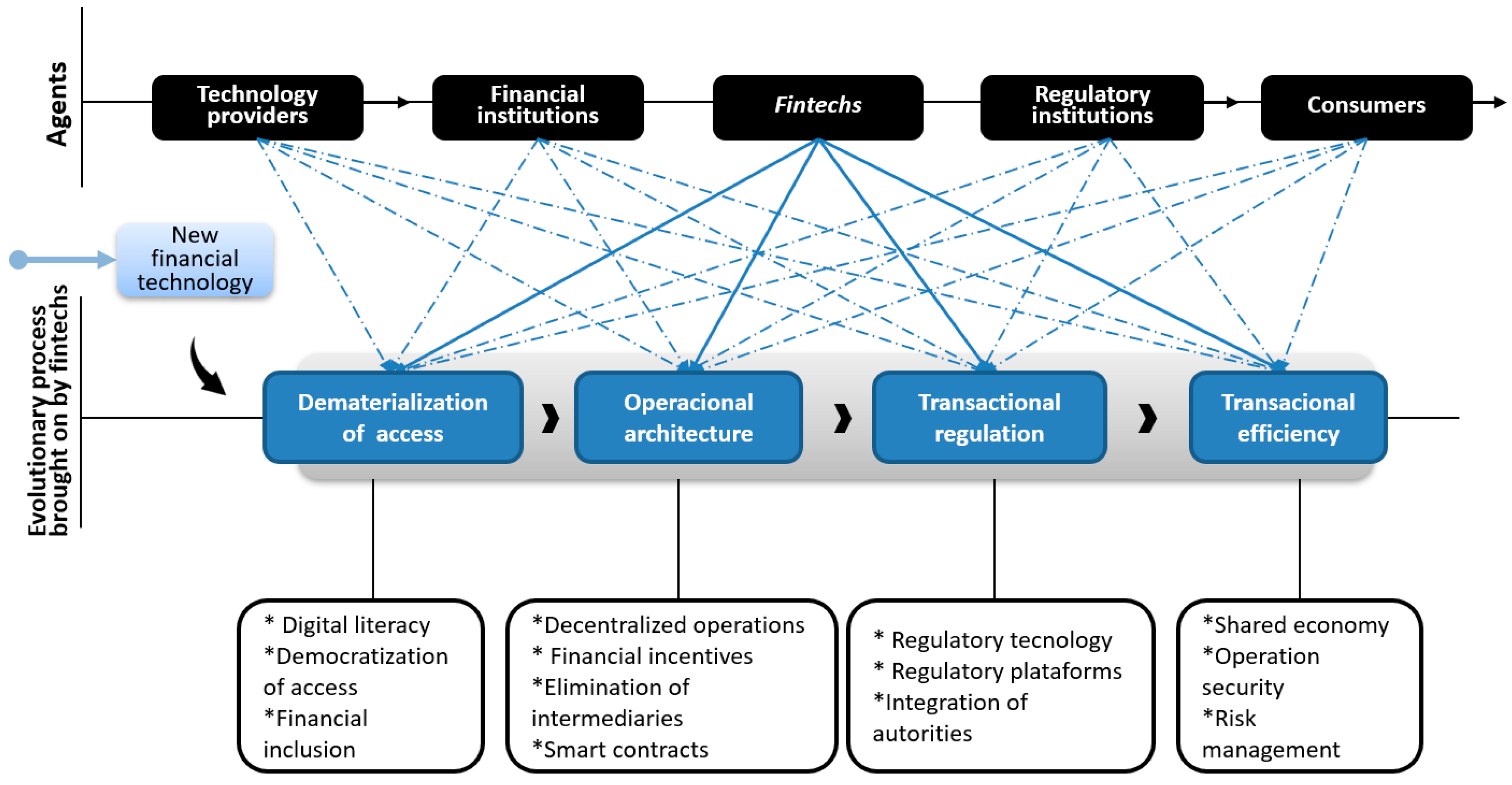
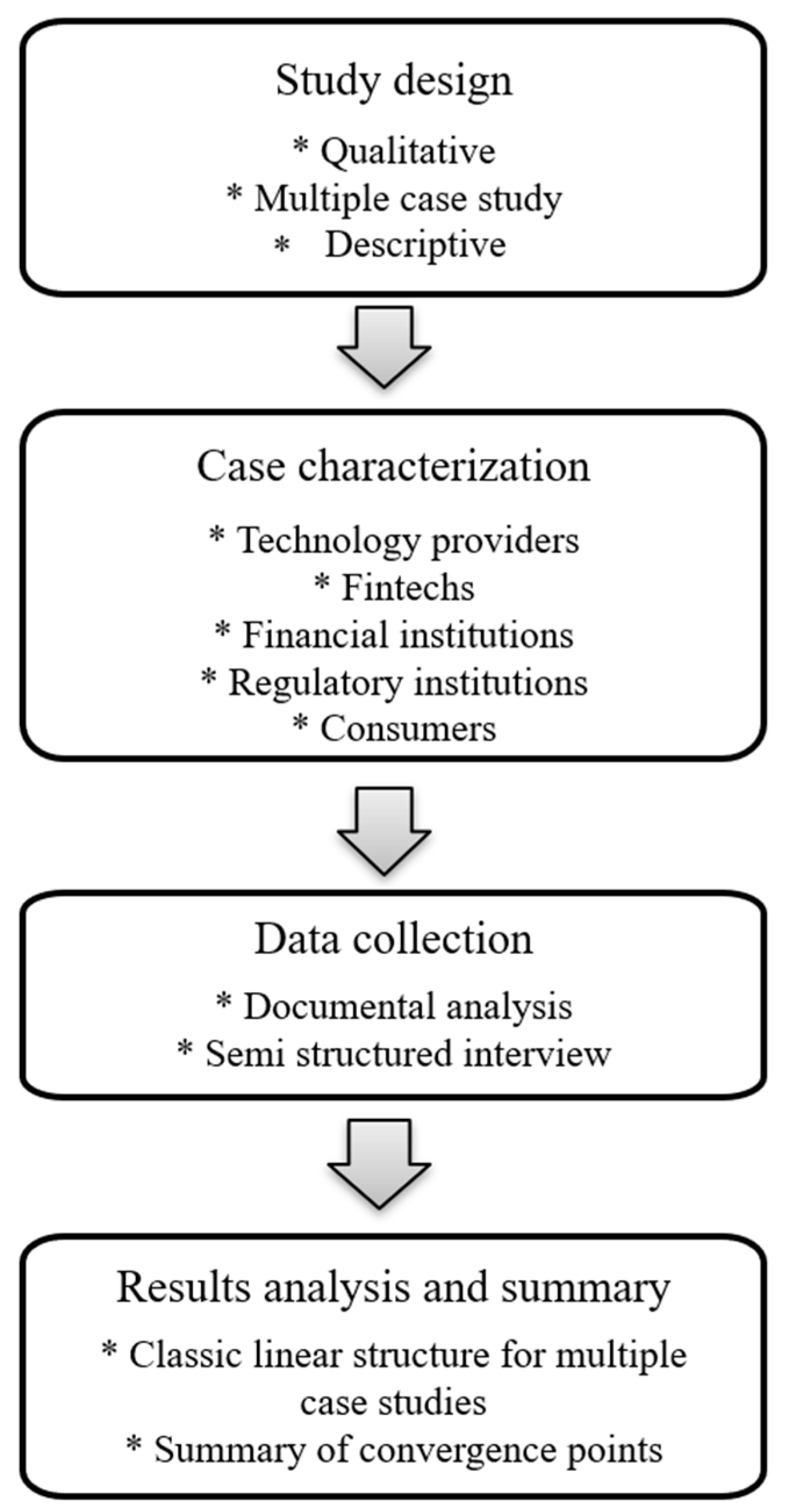
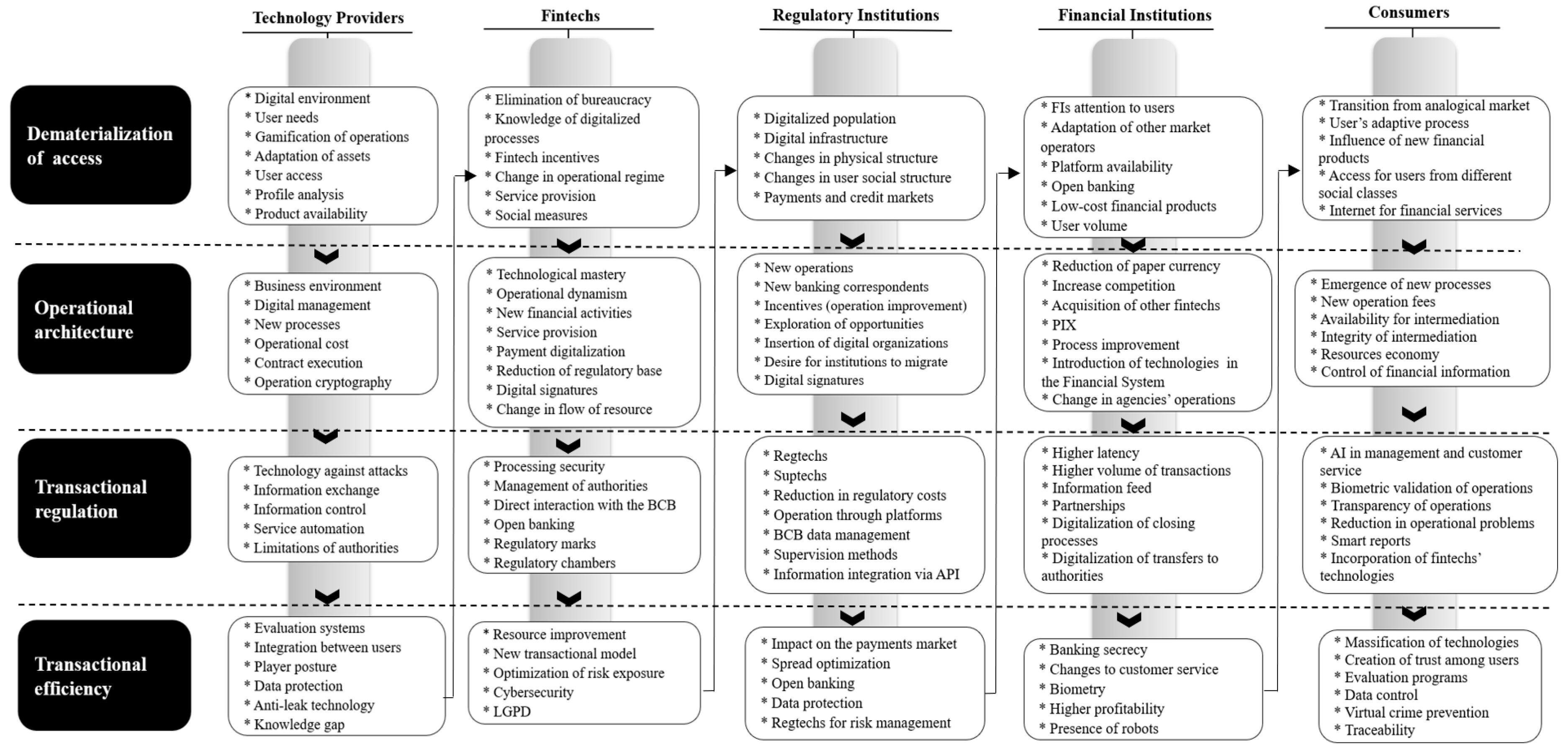
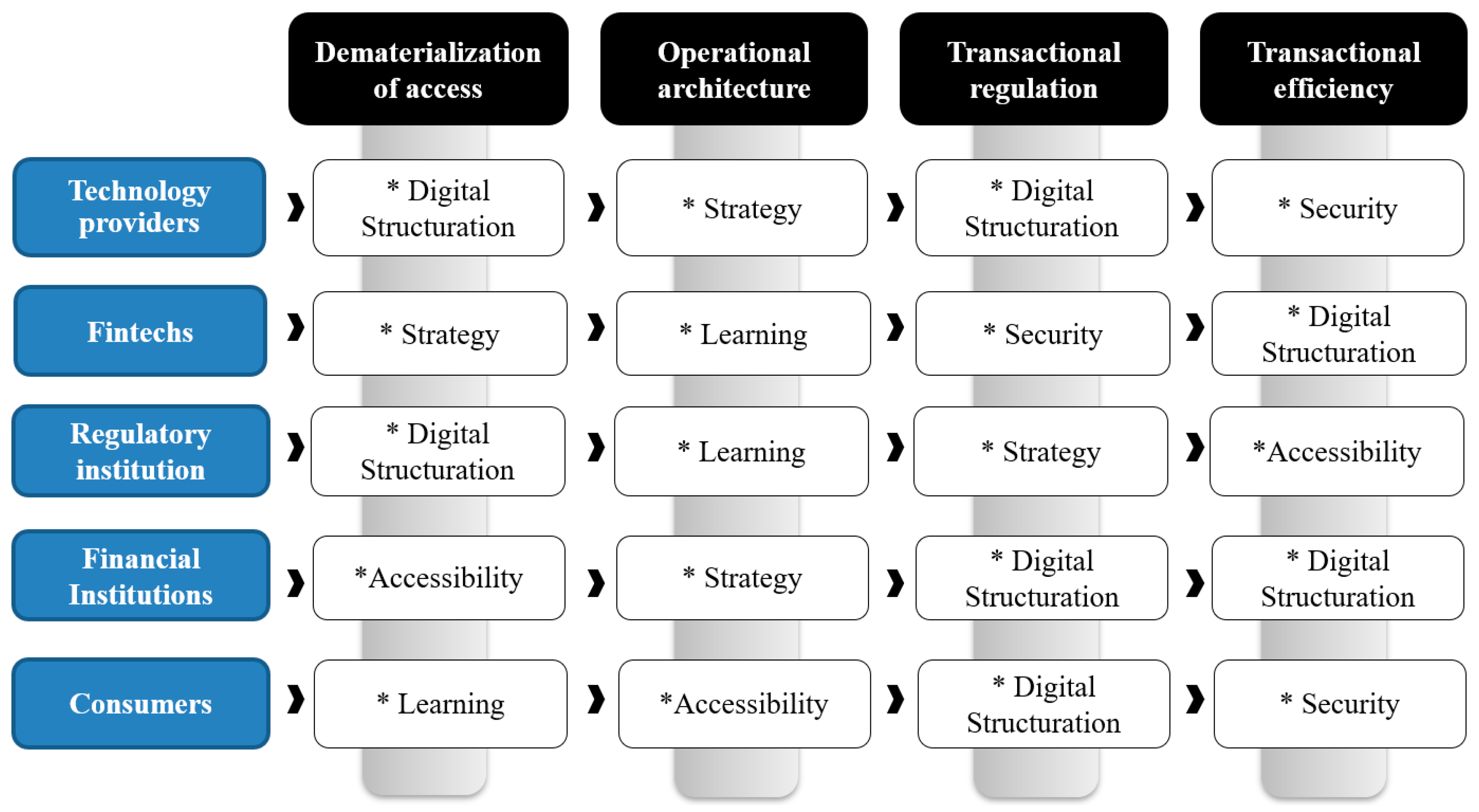
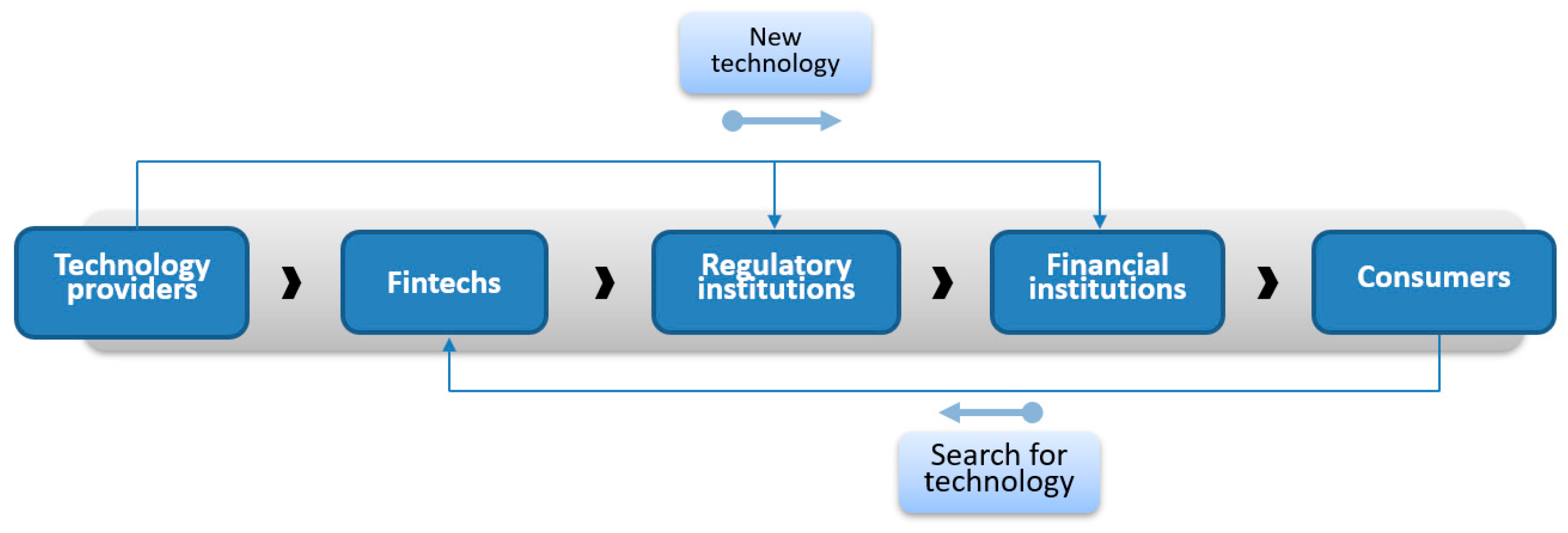
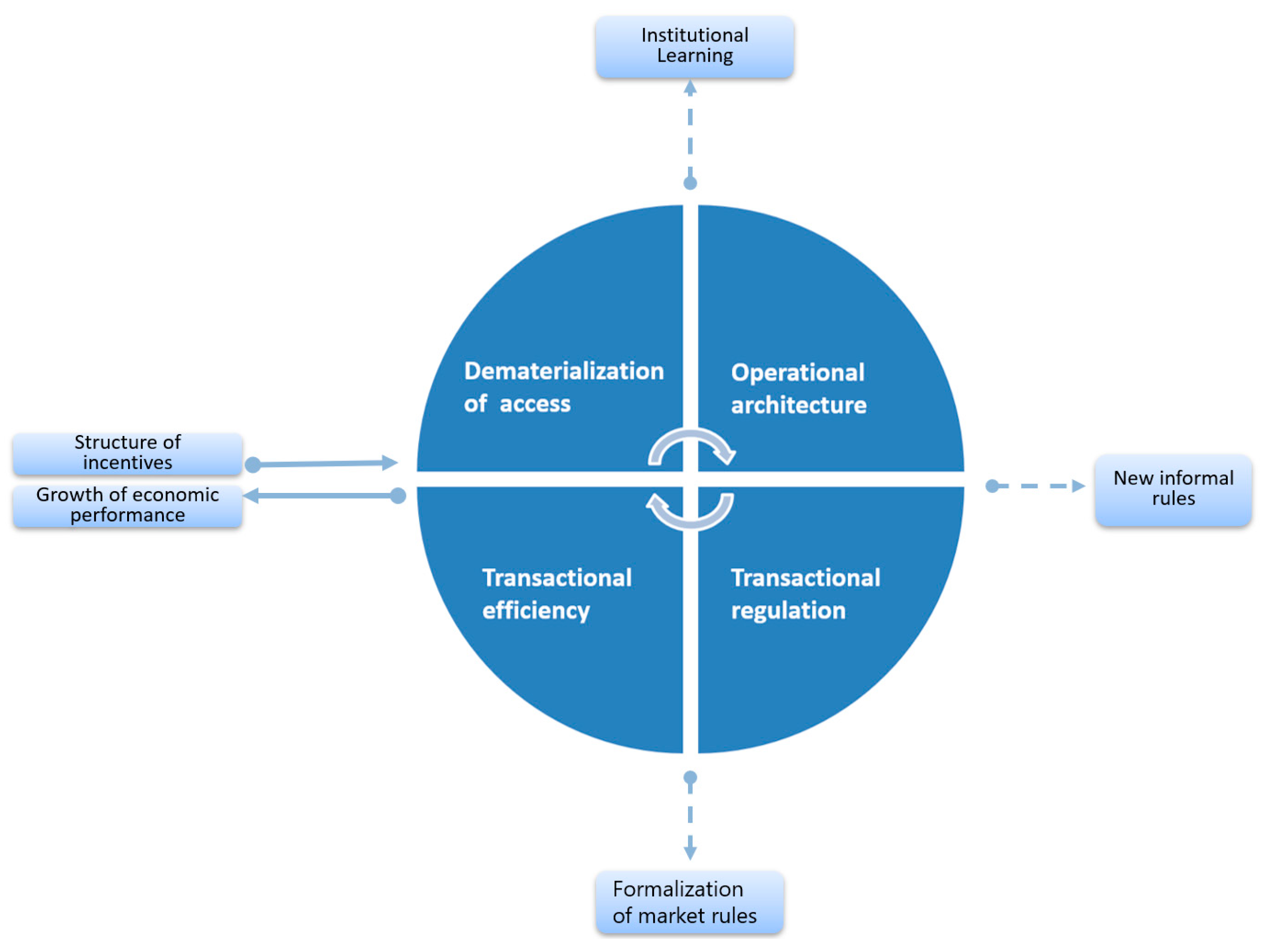
| Dimensions | Variables | References |
|---|---|---|
| Dematerialization of access |
| Hadad and Bratianu (2019) Jünger and Mietzner (2019) Ozili (2018) I. Lee and Shin (2018) Cumming and Schwienbacher (2018) Petrushenko et al. (2018) |
| Operational architecture |
| Chen and Bellavitis (2020) Jiang et al. (2018) Brownsword (2019) Soloviev (2018) Shkodina et al. (2019) Shkarlet et al. (2018) |
| Transactional regulation |
| Gomber et al. (2017) Yang and Li (2018) Irwin and Dawson (2019) Brownsword (2019) Bukhtiarova et al. (2018) Romanova et al. (2018) |
| Transactional efficiency |
| Zveryakov et al. (2019) Zetzsche and Preiner (2018) I. Lee and Shin (2018) Kraus et al. (2020) Tarkhanova et al. (2018) |
| Institution | Position | Headquarter | Characteristics |
|---|---|---|---|
| Technology providers | |||
| Technology provider 1 | Co-Founder and CTO | São Paulo, BR | SAAS platform provider |
| Technology provider 2 | Edge Specialist Senior Manager | California, US | Edge computing full stack platform |
| Technology provider 3 | Co-Founder and CTO | São Paulo, BR | SAAS platform provider |
| Fintech | |||
| Fintech 1 | Founder and COO | São Paulo, BR | Digital Bank |
| Fintech 2 | Founder and CEO | Florianópolis, BR | Investment |
| Fintech 3 | Founder and Senior Advisor | São Paulo, BR | Payment |
| Regulatory Institution | |||
| Regulatory Institution 1 | Senior Advisor at DENOR | Brasília, BR | DENOR |
| Regulatory Institution 2 | Technical Manager at DESUC | Brasília, BR | DESUC |
| Regulatory Institution 3 | Associate Director at DECEM | São Paulo, BR | DECEM |
| Financial Institution | |||
| Financial Institution 1 | Cooperative Business Manager | Rio Grande do Sul, BR | Credit Cooperative |
| Financial Institution 2 | Senior Operations Specialist Manager | Madrid, ES | Banks and Savings Banks |
| Financial Institution 3 | IT Application Development Manager and Business Specialist | São Paulo, BR | Securities brokers and distributors |
| Consumers | |||
| Consumer 1 | Entrepreneur | São Paulo, BR | Entrepreneur |
| Consumer 2 | Research Fellow | São Paulo, BR | Earns twice the minimum wage |
| Consumer 3 | Student | Rio Grande do Sul, BR | Earns minimum wage |
| Variables | Digital Literacy | Democratization of Access | Financial Inclusion |
|---|---|---|---|
| Technology providers |
|
|
|
| Fintechs |
|
|
|
| Regulatory institutions |
|
|
|
| Financial institutions |
|
|
|
| Consumers |
|
|
|
| Variables | Facilitation of P2P Resources | Financial Incentives | Elimination of Intermediaries | Smart Contracts |
|---|---|---|---|---|
| Technology providers |
|
|
|
|
| Fintechs |
|
|
|
|
| Regulatory institutions |
|
|
|
|
| Financial institutions |
|
|
|
|
| Consumers |
|
|
|
|
| Variables | Integration of Regulatory Technologies | Integration of Regulatory Platforms | Interaction Among Regulatory Authorities |
|---|---|---|---|
| Technology providers |
|
|
|
| Fintechs |
|
|
|
| Regulatory institutions |
|
|
|
| Financial institutions |
|
|
|
| Consumers |
|
|
|
| Variables | Shared Economy | Security in Operations | Technological Risk Management |
|---|---|---|---|
| Technology providers |
|
|
|
| Fintechs |
|
|
|
| Regulatory institutions |
|
|
|
| Financial institutions |
|
|
|
| Consumers |
|
|
|
Disclaimer/Publisher’s Note: The statements, opinions and data contained in all publications are solely those of the individual author(s) and contributor(s) and not of MDPI and/or the editor(s). MDPI and/or the editor(s) disclaim responsibility for any injury to people or property resulting from any ideas, methods, instructions or products referred to in the content. |
© 2025 by the authors. Licensee MDPI, Basel, Switzerland. This article is an open access article distributed under the terms and conditions of the Creative Commons Attribution (CC BY) license (https://creativecommons.org/licenses/by/4.0/).
Share and Cite
Campos-Teixeira, D.; Tello-Gamarra, J.; Reis, J.; Longaray, A.A.; Hernani-Merino, M. Fintechs and Institutions: Evidence from an Emerging Economy. J. Risk Financial Manag. 2025, 18, 212. https://doi.org/10.3390/jrfm18040212
Campos-Teixeira D, Tello-Gamarra J, Reis J, Longaray AA, Hernani-Merino M. Fintechs and Institutions: Evidence from an Emerging Economy. Journal of Risk and Financial Management. 2025; 18(4):212. https://doi.org/10.3390/jrfm18040212
Chicago/Turabian StyleCampos-Teixeira, Diogo, Jorge Tello-Gamarra, João Reis, André Andrade Longaray, and Martin Hernani-Merino. 2025. "Fintechs and Institutions: Evidence from an Emerging Economy" Journal of Risk and Financial Management 18, no. 4: 212. https://doi.org/10.3390/jrfm18040212
APA StyleCampos-Teixeira, D., Tello-Gamarra, J., Reis, J., Longaray, A. A., & Hernani-Merino, M. (2025). Fintechs and Institutions: Evidence from an Emerging Economy. Journal of Risk and Financial Management, 18(4), 212. https://doi.org/10.3390/jrfm18040212








